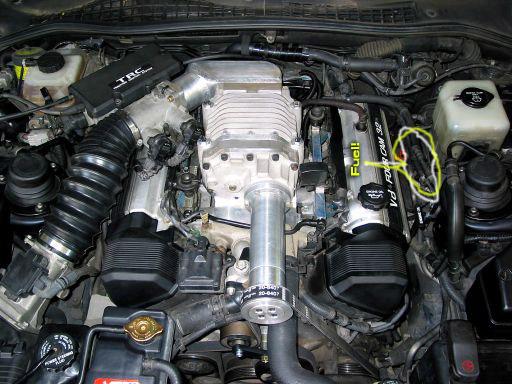 |
My Soarer Won't Start (Why OBD is your friend) |
Well, I have learnt a lot this week (and most of it the hard way). I got up in the morning to discover my precious soarer wouldn't start. It cranked over just fine, but it just wouldn't catch.
Diagnosis of the problem was complicated by the fact that I had driven her home on an empty tank. I don't know about your soarer, but mine seems to have only a very vague idea of how much petrol is in the tank at any given time. And since the onset of blinky dash, my poor beast is continually exclaiming a Japanese version of "FUEL"... and making that shrill beep that always draws a barrage of questions from any new passengers.
Anyway, I have digressed. Obviously (or so I thought at the time) the problem was fuel related. So I jumped on my little scooter to grab a few litres of petrol in a handy container. That failed to improve anything, and my container was spilling petrol everywhere. So eventually I conceded it would be necessary to purchase one of those overpriced fuel containers from my local.
$8 for a can! Highway robbery. But of course, my choices were few so I shelled out the money and filled her up.
Still no joy from my car. Wouldn't start. I repeated the trip on my scooter, and 5L at a time filled my car until it was almost 1/3 full of petrol. Still no joy. I was heartbroken! What could the problem be!
Fuel related problems still seemed obvious to me, so I then progressed to changing the fuel filter, thanks to Peter's excellent guide (http://planetsoarer.com/fuelfilter/Fuel_Filter.htm). My main logic here was that maybe a heap of dirt from the bottom of the tank had clogged the filter.
So $70 and a petrol soaked arm later, I had changed the filter. Still nothing!
The moron that I am, I was still unwilling to dismiss fuel as a problem. A friend came over and educated me on "fuel rails" and the like. We found the fuel entered and left the engine, and using the fuel-pump trick on the diagnostic port, verified fuel was entering, and leaving the engine.
I've attached a picture showing where the fuel rails are. The one on top (or more easy to access) is fuel before it enters the engine, and the other is fuel after it leaves the engine. You can open either of these, and stick a length of hose attached to a bottle, and then make sure fuel comes out! (After you jumper the fuel pump to start via the diagnostic port - watch out, it sparks sometimes when you make that connection, could be explosive!)

So that was fuel ruled out. We had 1/3 of a tank, it was flowing through the engine and it still wouldn't catch. It would make the occasional bang however, and send some smoke out of the air filter. But I was pretending to ignore that ominous sign.
Well, it's pretty common knowledge that a working engine is comprised of fuel + spark. So with Peter's excellent Spark Plug/Lead guide in hand (http://planetsoarer.com/penski/ThePenskiFile.html) I set out to confirm that there was indeed spark.
Now until this point, I had basically ignored the fact that the Soarer has a reasonably advanced OBD program (on board diagnostics). And this was a big mistake. In my defence, it wasn't all my fault. I had blown up my EMV a year or so back, and my blinky dash was barely ever functional, so there weren't actually a whole lot of ways to read the output from the OBD.
But remembering that in fact I was a computer nerd and not a mechanic, I thought it best to check out this OBD I had heard so much about. So I left the ignition on for about 2 hours until the dash stopped blinking (I'm still unwilling to actually repair the darn thing, even though I have all the components right here).
Running both the standard diagnostic routines, and the engine ones (the latter are more important to the crucial running of the engine), I got a most distressingly long list of errors.
(Standard diagnostics, obtained by connecting Tc and E1 on the engine diagnostic port and turning on the ignition)
ABS NG 34 36
SUS NG 51 73
TRC NG A/D OK
(Engine diagnostics, obtained by connecting E1 and TE1 on the engine diagnostic port and turning on the ignition)
EFI NG 13 24 12
ECT OK
Now a few tricks for young players here. Firstly, it pays to actually rest your ECU before doing those tests, otherwise you may be seeing old errors that aren't relevant to your current problem. (My ABS has been playing up earlier that week, for instance, but was okay now).
So save yourself the scare, and yank out the ECU fuse for 30 seconds before you embark on your diagnostics. (The ECU fuse is the only 30AMP fuse in your engine-bay fuse box, located bottom right).
The other trick is that some of the system will always give errors when the car isn't started. Which of course was the ONLY state the car was going to be in until I had fixed the problem.
After initially fearing the worst, I had ripped up my carpet to see if my ECU was somehow charred and burned .. because by the look of things, it looked like almost every computer in my car was malfunctioning. What I found scared my quite senseless for 20-30 minutes. Underneath my passenger side carpet, it was actually quite wet!
Now if you know where your ECU lives, (and if you don't, then I suggest you are probably reading the wrong guide), then maybe you'll appreciate my panic.
Fortunately it turns out that the ECU was quite dry, so I'm going to ignore the wet-foam-under-carpet problem. I'm assuming it comes from all those plastic things that used to live under my car (stone guards or whatever they're called) finally falling off when the cable ties couldn't hold them on any more.
Anyway, the point was that I was wearing an onion on my belt, which was the style at the time. Or was that another story....
Now the problem with all the lovely OBD information that I had gotten, is that there actually isn't anywhere to look up these codes! Something they don't seem to mention in the many guides to accessing you diagnostic information, is what do with it once you get it!
A quick email whip around the tri-state soarer experts failed to elicit any information, but eventually I hit upon the notion that the codes might be generic among different models by the same manufacturer. A comparison of a Toyota 4WD side and an American Lexus table showed identical codes, so I felt fairly safe in assuming that these codes would also hold true for my Soarer.
Now I could be cruel, and not tell you where to find these codes, and believe me, it took me a LONG TIME. But cruelly isn't my strong point, so you can get them at (http://www.troublecodes.net/Lexus). Now, these are only the codes for the EFI section. I don't know much about the other sections, although I did find a generic suspension code guide somewhere, but I wasn't terribly sure it was even for a Toyota.
I'm going to duplicate the codes in this text, since I think they're a fairly important thing to know, and there aren't nearly enough sites that list them. For more help on possible causes for these error message, you can check http://www.off-road.com/toyota/tech/codes for some hints.
Standard Toyota ECU/EFI diagnostic codes:
12 RPM Signal
13 RPM Signal
14 Ignition Signal
15 Ignition Signal
16 Electronically Controlled Transmission Control Signal
17 CMP No. 1
18 CMP No. 2
21 Main O2S & Heater Signal
22 ECT Sensor Signal
24 IAT Sensor Signal
25 Air–Fuel Ratio Lean Malfunction
26 Air–Fuel Ratio Rich Malfunction
27 Sub O2S Signal
28 Main O2S
29 Sub O2S
31 & 32 Air Flow Meter Signal
35 HAC/Barometric Pressure Sensor Signal
41 TP Sensor Signal
42 VSS Signal
43 Starter Signal
47 Sub TP Sensor
48 Secondary Injection System Malfunction
51 Switch Condition Signal
52 KS Signal
53 Knock Control Signal
55 KS Signal
70 EGR System Malfunction
71 EGR System Malfunction
78 Fuel Pump Control
Now if you remember, the EFI codes I was getting were 12 and 13. Both were listed as "RPM signal". The reasons between there being two codes for the same problem arent' really important right now, but if you're interested you can check that 4wd'ing site. The other code was something about air temp., so I ignored that. It has miraculously gone away now anyway.
Now I didn't really have much of an idea about where this signal would be coming from, or how I'd check it. I had ordered the Soarer Bible from Jeff earlier that day, but it wouldn't' arrive in time to quickly solve my problem.
I recalled reading on another Soarer guide, that checking your Crank Angle Sensor was a pretty good idea if you car wouldn't start. So, not really knowing what a Crank Angle Sensor was, (and honestly, I still don't), we set on our a discovered mission, and found a most alarming thing.
Toward a round doover (I hope you don't mind if I use technical terms here) on the fan belt, that we guessed might be a Crank Angle Sensor, we discovered that a wire had actually become somewhat too familiar with the fan belt. So familiar in fact, that it had worn away it's protective plastic coating and shield wire, and had shorted itself to it's own shielding.
We had found our RPM sensor wire, and we had found our problem. But not before wasting 3 evenings getting our hands dirty instead of looking towards the OBD for initial guidance.
I think there's a lesson in that for all of us. :)
We stripped, insulated, and re-shielded the wire with alfoil and duct tape. And of course re-routed it from the imminent peril of the fan belt (although truth told, it's still only a few mm away).
Thanks to Peter Scott for his assistance and excellent web site, and especially the picture showing the diagnostic port pin-outs, without which I would have been truly lost.... To Mark Trueno, for getting soaking wet while helping me find various car-bits (doovers) in the pouring rain.
And also Jeff Harper, whose manuals I'm sure would have saved the day much quicker, had I ordered them previously. :)
Cyrus